Excavation Contractors Union
Top 10 Excavation Services in Union
Receive 3 FREE Excavation Company Near Me quotes for your project today! Compare profiles, reviews, accreditations, portfolio, etc... and choose the best deal.
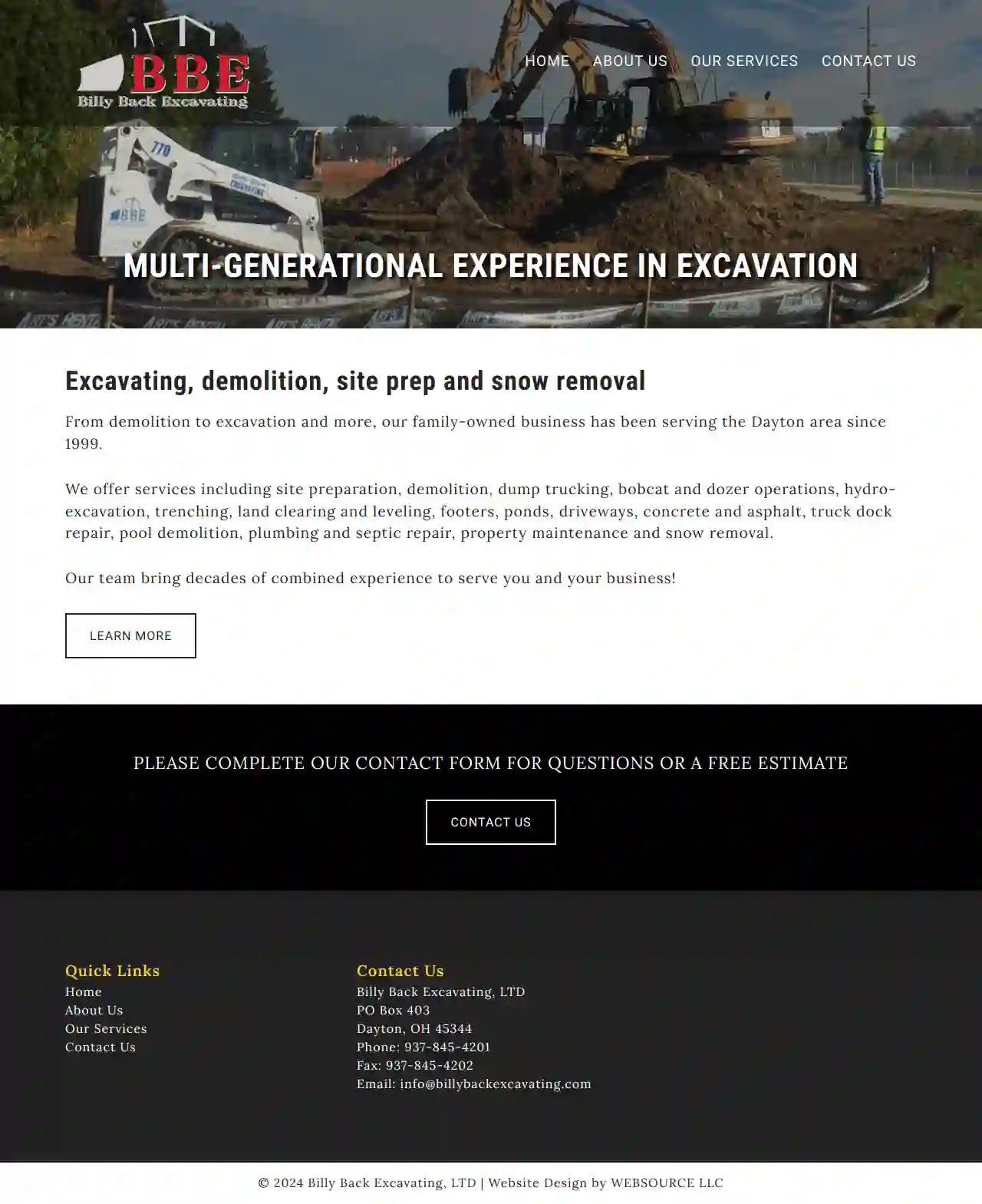
Billy Back Excavating LTD
3.33 reviewsPO Box 403, Dayton, 45344, USMulti-Generational Experience in Excavation Billy Back Excavating has been serving the Dayton area since 1999, offering a wide range of services for both residential and commercial clients. Our family-owned business is committed to providing high-quality workmanship and exceptional customer service. We take pride in our multi-generational experience and dedication to exceeding expectations. From demolition to excavation and more, we have the expertise and equipment to handle any project, big or small. Our team brings decades of combined experience to serve you and your business! We are committed to providing our clients with the highest level of service and satisfaction. We offer free estimates and are always available to answer your questions.
- Services
- Why Us?
- Gallery
Get Quote
High Country Excavation, LLC - Landscape Excavator Service & Demolition Excavation Contractor
57 reviewsHigh Country Excavation, LLC, Lakewood, CO, 80235, USAbout High Country Excavation, LLC High Country Excavation, LLC is a trusted local excavator in Lakewood, CO, serving residential property owners with a wide range of services beyond just excavation. We've been serving the community for over a decade, building a reputation for quality work and customer satisfaction. Our Services We specialize in a variety of excavation projects, including septic system installation, landscape excavation, site preparation, tree removal, snow removal, drainage, demolition, rock wall construction, and more. We're equipped to handle a wide range of projects, from small-scale landscaping to large-scale construction. Our Work Process We believe in optimizing our work process to ensure efficiency and cost-effectiveness. We carefully plan each project, providing realistic timelines and cost estimates. We're committed to delivering high-quality results on time and within budget.
- Services
- Why Us?
- Accreditations
- Gallery
Get Quote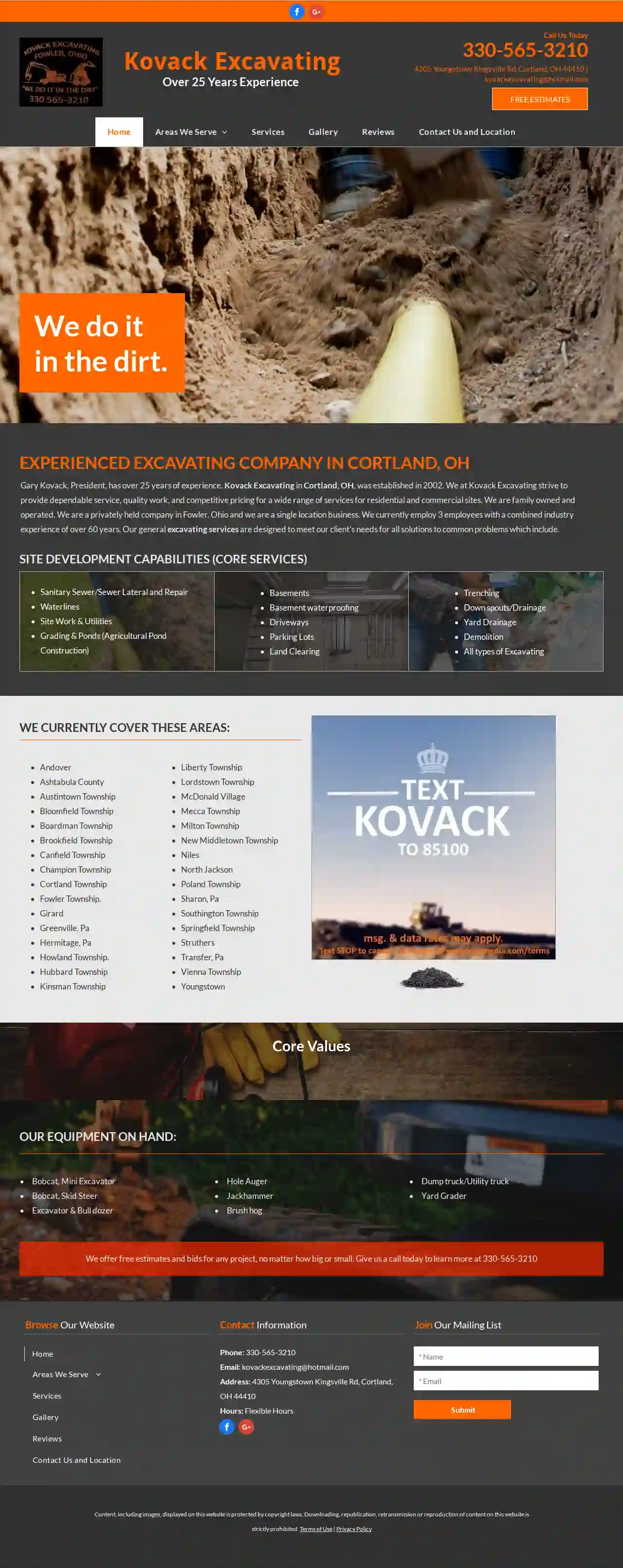
Kovack Excavating
52 reviews4305 Youngstown Kingsville Rd, Cortland, 44410, USKovack Excavating: Your Trusted Partner for Excavation Services in Cortland, OH Kovack Excavating is a family-owned and operated business with over 25 years of experience serving the Cortland, OH area. Led by Gary Kovack, our team is dedicated to providing dependable service, quality work, and competitive pricing for a wide range of residential and commercial excavation projects. We understand the importance of exceeding client expectations and strive to deliver solutions that meet your specific needs. We are proud to be a privately held company in Fowler, Ohio, and we are committed to serving our local community. Our team of experienced professionals brings over 60 years of combined industry experience to every project. We are fully licensed, bonded, and insured, ensuring peace of mind for our clients. At Kovack Excavating, we believe in building strong relationships with our clients. We offer free estimates and on-site evaluations before every job, ensuring transparency and clear communication throughout the process. We are committed to safety, integrity, and exceeding client expectations. Our core values guide everything we do, ensuring a positive and reliable experience for every client. We are proud to serve the following areas: Andover, Ashtabula County, Austintown Township, Bloomfield Township, Boardman Township, Brookfield Township, Canfield Township, Champion Township, Cortland Township, Fowler Township, Girard, Greenville, PA, Hermitage, PA, Howland Township, Hubbard Township, Kinsman Township, Liberty Township, Lordstown Township, McDonald Village, Mecca Township, Milton Township, New Middletown Township, Niles, North Jackson, Poland Township, Sharon, PA, Southington Township, Springfield Township, Struthers, Transfer, PA, Vienna Township, and Youngstown.
- Services
- Why Us?
- Our Team
- Gallery
Get Quote
High Country Excavation, LLC
Lakewood, USHigh Country Excavation LLC I’m Luke Califano, an Excavation Contractor in the Conifer Front Range area. I grew up on the Western Slope on a ranch and have been in construction and excavation my entire life. High Country Excavation LLC does various types of work, including foundation excavation, backfill, tree removal, clearing, demolition, utilities, slab prep, driveways, snow removal, and more. Customer satisfaction is my job security. I have a passion for what I do and take pride in my work, and the same goes for my employees. I offer free estimates and fair bids. Give me a call!
- Services
- Why Us?
- Gallery
Get Quote
Ady Excavating
3.73 reviewsYoungstown, USBuilt on Quality and Dedication Ady Excavating offers a wide variety of services to Industrial, Commercial, Residential, and Municipal customers. Our team is dedicated to providing high-quality workmanship and exceptional customer service. We are committed to safety and environmental responsibility on every project. We have a proven track record of success in the culvert industry, with thousands of feet of Paved invert repairs and slip lining under our belt. We are the perfect choice to take care of any failing culvert. We utilize the Mr. Manhole method to bring all of your adjustment needs to today's ODOT standards. Whether it's a large project or a small repair, we have you covered. With all of our company's past experience and success in the culvert industry, we now offer culvert inspections and consultations. Contact us today to get your inspection scheduled.
- Services
- Why Us?
- Gallery
Get Quote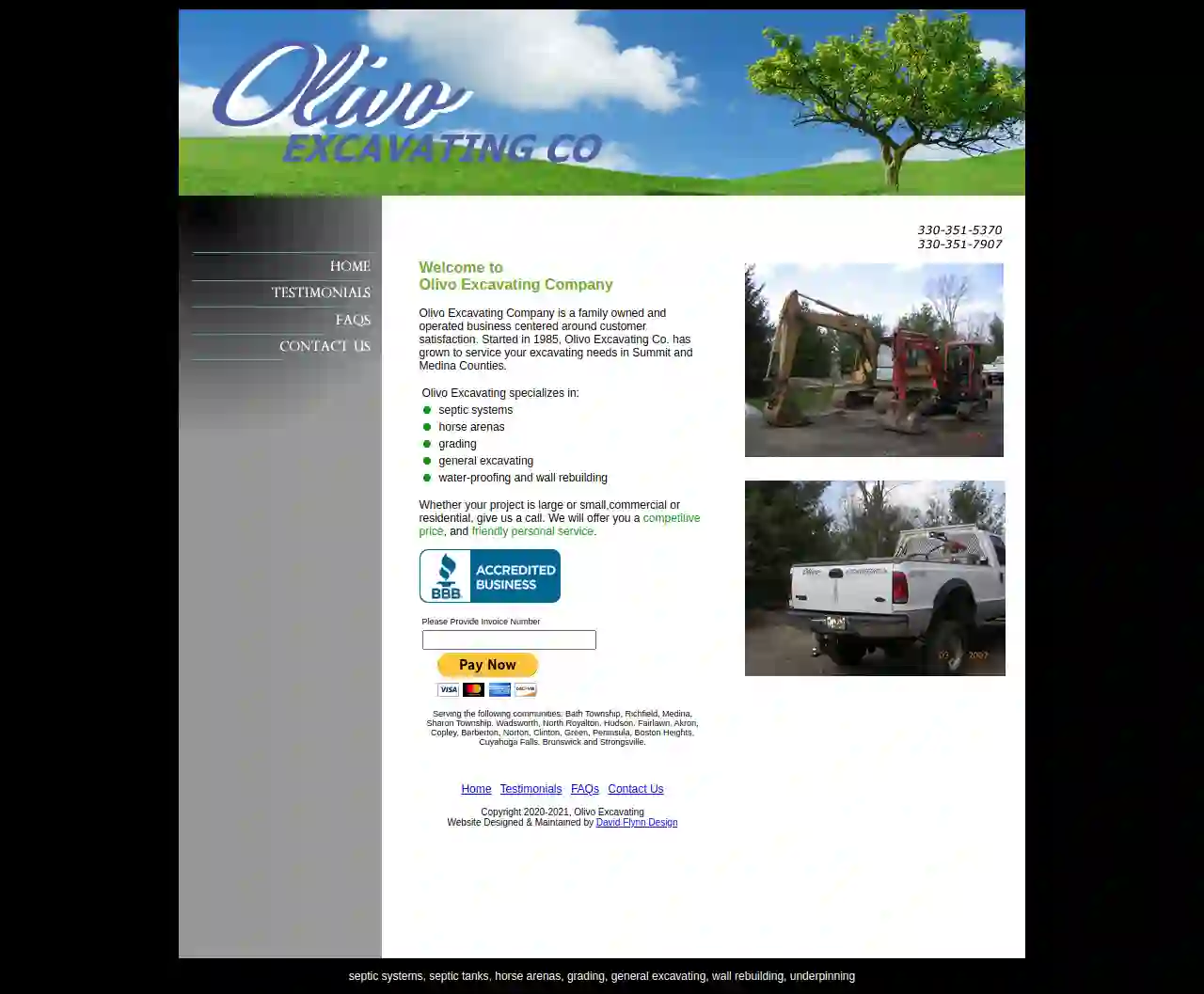
Olivo Excavating Co
4.834 reviewsAkron, USAbout Olivo Excavating Company Olivo Excavating Company is a family-owned and operated business deeply committed to customer satisfaction. Established in 1985, Olivo Excavating Co. has expanded its services to meet the excavating needs of clients in Summit and Medina Counties. We specialize in a wide range of excavating services, including: Septic Systems Horse Arenas Grading General Excavating Waterproofing and Wall Rebuilding Whether your project is large or small, commercial or residential, we invite you to contact us. We are dedicated to providing competitive pricing and friendly, personalized service. We proudly serve the following communities: Bath Township, Richfield, Medina, Sharon Township, Wadsworth, North Royalton, Hudson, Fairlawn, Akron, Copley, Barberton, Norton, Clinton, Green, Peninsula, Boston Heights, Cuyahoga Falls, Brunswick, and Strongsville.
- Services
- Why Us?
- Testimonials
- Gallery
Get Quote
Mike Pusateri Excavating
4.85 reviews16363 Saint Clair Avenue, East Liverpool, 43920, USA Family Owned Commercial and Residential Excavating Company Mike Pusateri Excavating Inc is a Commercial and Residential Excavating Company that prides itself in the quality of work and high standards of performance it provides for our customers. These qualities and principles have been the foundation of the company since 1960. We continue to take pride in our work and strive for excellence resulting in top quality projects that reflects the reputation we have built over the years and continue to stand by. The Company was founded by Michael Pusateri Sr. in 1960. It all started with a dump truck and high lift. The company continued to grow due to the hard work and success over the years. Eventually, the reins were turned over to the next generation when Mike Pusateri Jr and brother Jim Pusateri took over the responsibilities. During these years the company began to expand, and their equipment fleet and capabilities grew larger. Mike Pusateri Jr. is still the acting President of the company and now with the addition of a third generation to include sons Matt and Jason Pusateri as well as nephew Adam Pusateri, the company continues to grow maintaining the reputation it was built upon. The fleet now has GPS modeling and machine control capabilities and are continually evolving to provide High Quality Projects.
- Services
- Why Us?
- Our Team
- Gallery
Get Quote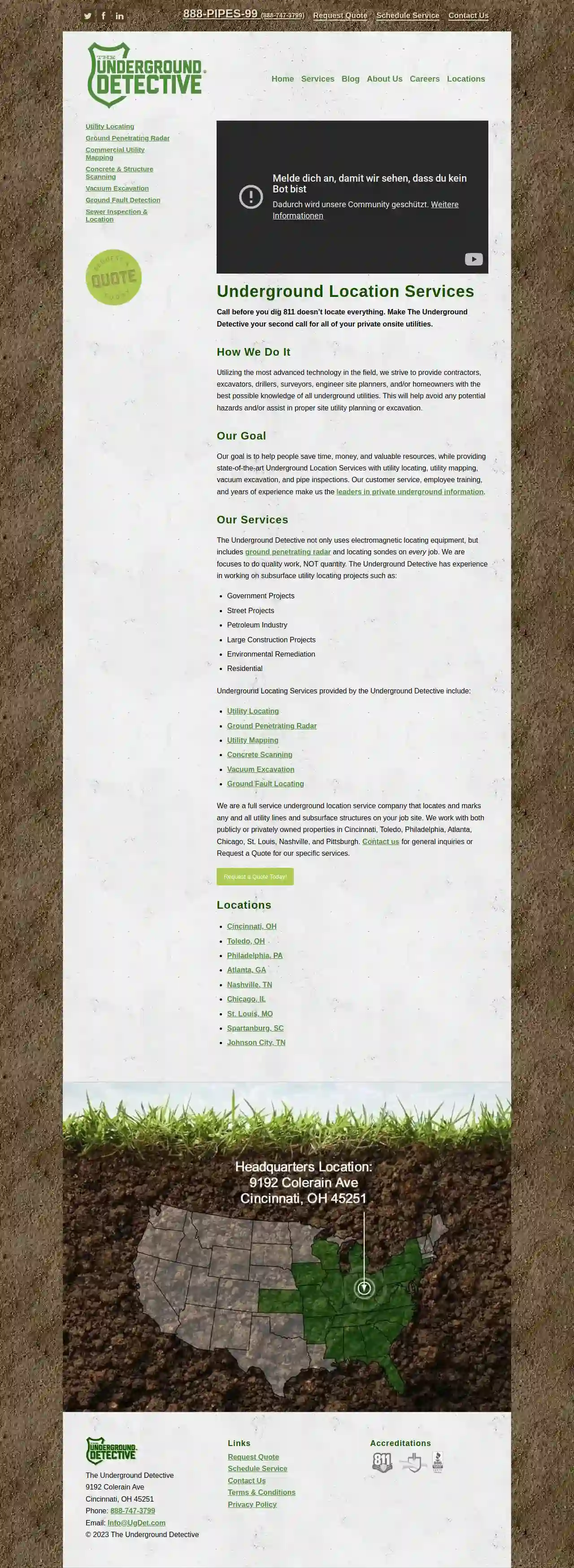
Underground Detective Cincinnati
4.620 reviews9192 Colerain Avenue, Cincinnati, 45251, USCommitted to excellence! The Underground Detective has grown and evolved to provide invaluable services to a wide variety of clients. As years progress and demand continues to change, our commitment to being a family remains strong. We value your time and your trust. We treat our name and your confidence #1 in everything we do and ALWAYS give you all the knowledge we can to save you time, money, and resources. Originally plumbers, the owner of The Underground Detective and his head technician often struggled to find the proper place to excavate when a sewer problem occurred. In 1975, they purchased a piece of equipment to locate underground utilities on their own. Other plumbers in the area began to use their new service, but it wasn’t until 1992 that The Underground Detective of Greater Cincinnati, LLC officially became a company. Since then, the company has grown and expanded to specialize in the location of many underground utilities. Our Mission We strive to provide contractors, excavators, surveyors, engineer site planners, and/or homeowners with the best possible knowledge of all underground utilities. This will help avoid any potential hazards and/or assist in proper site utility planning or excavation. Our goal is to help people save time, money, and valuable resources, while providing state-of-the-art utility locating, utility mapping, vacuum excavation, pipe inspections, and leak locating solutions. Our service and accuracy are unparalleled.
- Services
- Why Us?
- Gallery
Get Quote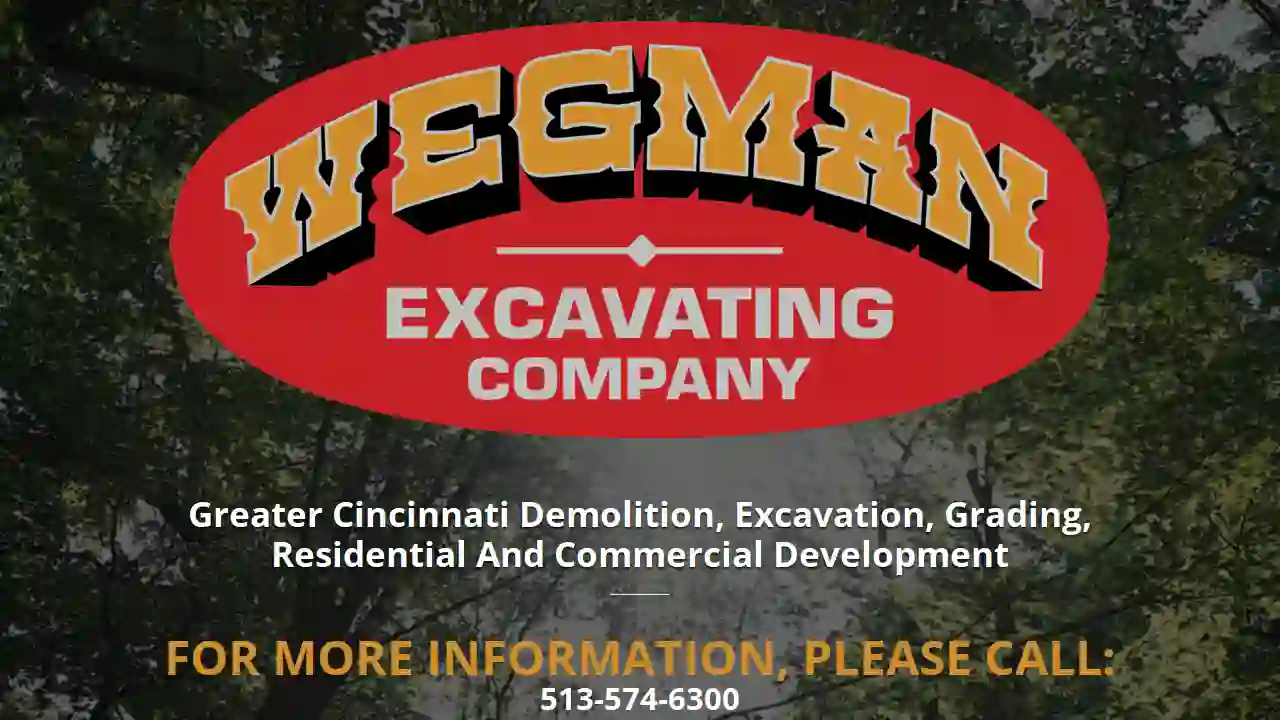
Wegman Excavating Company
52 reviewsCincinnati, USGreater Cincinnati Demolition, Excavation, Grading, Residential and Commercial Development Wegman Excavating is a family-owned and operated business serving the Greater Cincinnati area. We specialize in demolition, excavation, grading, and site preparation for residential and commercial projects. Our team of experienced professionals is committed to providing our clients with the highest quality workmanship and customer service. We are dedicated to safety and environmental responsibility, and we strive to complete all projects on time and within budget.
- Services
- Why Us?
- Gallery
Get Quote
Dynamic X Excavating
Youngstown, USWhat Your Business Needs If you're looking for solutions to carry your business past challenges and toward your goals, you need Dynamic X. We are an Ohio-based Excavating, Site Development and Demolition Contractor serving businesses across industries for quite some time. We'll create a unique plan to address your project needs, weaknesses and opportunities. Together, we'll help you address and facilitate at a high level in order to meet and exceed your project needs. We’re Dynamic X Excavating, and we’re here to help you complete your project needs efficiently, on time and cost effectively. We at Dynamic X believe in a business core that stems from professional encounters and a strong safety culture. We operate at an extremely high level and strive towards building impenetrable business relationships. Since our founding, we’ve guided countless clients to successful project solutions as well as helped achieve their unique project goals. Using our experience and proven end-to-end methods we’ll help facilitate a sure fired plan to succeed. You can count on our team to give you the best insights towards your immediate project needs. Join us today at Dynamic X Excavating.
- Services
- Why Us?
- Our Team
- Gallery
Get Quote
Over 22,076+ Excavation Businesses registered
Our excavation experts operate in Union & beyond!
ExcavationHQ has curated and vetted Top Excavation Contractors in and around Union. Find a reliable pro today.
Frequently Asked Questions About Excavation Contractors
- Project Size and Scope: Larger, more complex excavations naturally take longer.
- Soil Conditions: Rocky or challenging soil types can slow down progress.
- Site Accessibility: Limited access might require more time for maneuvering equipment and hauling materials.
- Weather: Inclement weather can cause delays.
- Permitting and Inspections: Waiting for permits or inspections can extend the timeline.
- Experience: Choose contractors with a proven track record and years of experience in excavation projects similar to yours.
- Licensing and Insurance: Verify that they are properly licensed to operate in your area and carry adequate insurance to protect you from liability in case of accidents or damage.
- Equipment and Resources: Ensure they have the necessary equipment and resources to handle your project efficiently and safely.
- Positive Reviews and References: Check online reviews and testimonials from previous customers. Request references and contact them to inquire about their experience with the contractor.
- Professionalism: Opt for a company that communicates clearly, provides detailed and transparent estimates, and has a responsive and courteous team.
- Spring and Fall: Often considered favorable due to moderate temperatures and drier soil conditions.
- Summer: Can be suitable, but hot weather can make working conditions challenging and might require additional measures (shade, hydration) for workers.
- Winter: Excavation in winter can be more difficult due to frozen ground, snow, and potential delays caused by inclement weather. It might also require specialized equipment or techniques.
- Trench Collapses: Unstable trench walls can cave in, posing a severe risk to workers. Proper shoring and sloping are crucial safety measures.
- Utility Damage: Striking underground utilities (gas, water, electric) can cause leaks, explosions, or electrocution. Accurate utility locates and careful digging are essential.
- Falling Objects: Materials or equipment falling into excavations can injure workers. Securing work areas and using appropriate safety gear is vital.
- Equipment Accidents: Operating heavy machinery involves risks of rollovers, collisions, or mechanical failures. Trained operators and proper equipment maintenance are critical.
- Environmental Hazards: Excavated soil might contain hazardous materials (asbestos, lead). Proper testing and disposal procedures are necessary.
How long does an excavation project take?
How do I find a good excavation contractor?
What is the best time of year for excavation?
What are the risks associated with excavation?
How long does an excavation project take?
- Project Size and Scope: Larger, more complex excavations naturally take longer.
- Soil Conditions: Rocky or challenging soil types can slow down progress.
- Site Accessibility: Limited access might require more time for maneuvering equipment and hauling materials.
- Weather: Inclement weather can cause delays.
- Permitting and Inspections: Waiting for permits or inspections can extend the timeline.
How do I find a good excavation contractor?
- Experience: Choose contractors with a proven track record and years of experience in excavation projects similar to yours.
- Licensing and Insurance: Verify that they are properly licensed to operate in your area and carry adequate insurance to protect you from liability in case of accidents or damage.
- Equipment and Resources: Ensure they have the necessary equipment and resources to handle your project efficiently and safely.
- Positive Reviews and References: Check online reviews and testimonials from previous customers. Request references and contact them to inquire about their experience with the contractor.
- Professionalism: Opt for a company that communicates clearly, provides detailed and transparent estimates, and has a responsive and courteous team.
What is the best time of year for excavation?
- Spring and Fall: Often considered favorable due to moderate temperatures and drier soil conditions.
- Summer: Can be suitable, but hot weather can make working conditions challenging and might require additional measures (shade, hydration) for workers.
- Winter: Excavation in winter can be more difficult due to frozen ground, snow, and potential delays caused by inclement weather. It might also require specialized equipment or techniques.
What are the risks associated with excavation?
- Trench Collapses: Unstable trench walls can cave in, posing a severe risk to workers. Proper shoring and sloping are crucial safety measures.
- Utility Damage: Striking underground utilities (gas, water, electric) can cause leaks, explosions, or electrocution. Accurate utility locates and careful digging are essential.
- Falling Objects: Materials or equipment falling into excavations can injure workers. Securing work areas and using appropriate safety gear is vital.
- Equipment Accidents: Operating heavy machinery involves risks of rollovers, collisions, or mechanical failures. Trained operators and proper equipment maintenance are critical.
- Environmental Hazards: Excavated soil might contain hazardous materials (asbestos, lead). Proper testing and disposal procedures are necessary.